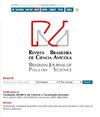The Growth Pattern of Brazilian Canela-Preta Chickens with Different Plumages Reared in Two Rearing Systems
IF 1.1
4区 农林科学
Q3 AGRICULTURE, DAIRY & ANIMAL SCIENCE
引用次数: 0
Abstract
Growth pattern is essential for economically efficient poultry production. In this study, we aimed to describe the growth curve of chickens of the Canela-Preta breed reared in two different rearing systems, considering their different plumage colors. Initially, 204 one-day-old male and female chicks were randomly distributed in confinement and semi-confinement (102 animals in each system) without separation by gender. The animals were individually identified by wing and foot plastic brands and were weighted every seven days. The body weight and age records were used to estimate the growth curves of the following factors using the Richards model: plumage color, gender, and rearing system. The likelihood ratio test was used to verify the equality of parameters and identify nonlinear models to compare the growth patterns of the evaluated groups. The growth pattern of Canela-Preta chickens changed as a function of gender, plumage color, and rearing system. Females with black plumage, black and gold hens, and males with black and white plumage showed greater sensitivity to changes in rearing systems. Within-breed selection strategies for specific colors can improve the use of growth pattern differences, improving production efficiency. Semi-confinement is suitable for rearing Canela-Preta chickens with any plumage color, as these animals meet the free-range poultry niche market requirements.两种饲养方式下不同羽毛巴西Canela-Preta鸡的生长规律
本文章由计算机程序翻译,如有差异,请以英文原文为准。
求助全文
约1分钟内获得全文
求助全文
来源期刊

Brazilian Journal of Poultry Science
农林科学-奶制品与动物科学
CiteScore
1.80
自引率
9.10%
发文量
60
审稿时长
>12 weeks
期刊介绍:
A Revista Brasileira de Ciência Avícola surgiu em 1999 a partir da necessidade que a comunidade científica possuía de um periódico para veiculação e publicação de seus trabalhos, com a publicação de três números anuais.
A Revista conta hoje com um corpo editorial altamente qualificado e com artigos científicos desenvolvidos pelos maiores especialistas da área, o que a cada dia atrai mais leitores em busca de inovação e respaldo técnico.
Devido à credibilidade que conquistou pelos esforços de sus autores, relatores e revisores, a Revista ganhou caráter de coleção, sendo consultada como fonte segura de estudo desenvolvidos na Avicultura.
A partir de 2003 – volume 5 -, a Revista passou a chamar-se Brazilian Journal of Poultry Science, e todos os trabalhos passaram a ser publicados em inglês. No mesmo ano subiu para quatro o número de revistas por volume, ampliando-se assim os trabalhos publicados anualmente.
 求助内容:
求助内容: 应助结果提醒方式:
应助结果提醒方式:


